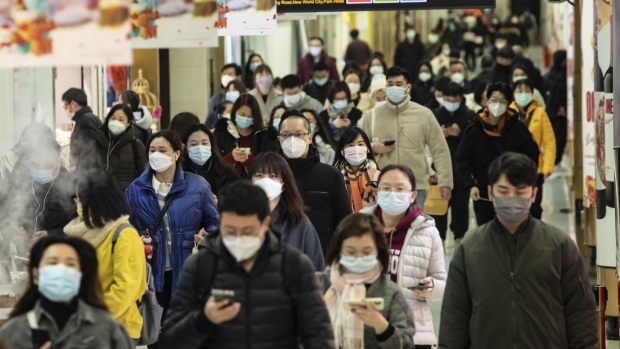Dec 11, 2022
China’s Top Medical Adviser Says Omicron Risks Similar to Flu
, Bloomberg News

(Bloomberg) --
Chinese officials continued to downplay the risks of Covid-19 as restrictions are eased, with a top medical adviser saying the fatality rate from the omicron variant of the virus is in line with influenza.
The death rate from omicron is around 0.1%, similar to the common flu, and the infection rarely reaches the lungs, Zhong Nanshan was quoted in an interview with state news agency Xinhua. Most people recover from the variant within seven to 10 days, he said.
Zhong’s comments follow the government’s latest line on the coronavirus, which talks down the disease’s dangers as China moves toward exiting its Covid Zero policy. The nation reported 10,514 local infections for Saturday, more than 20% lower than Friday. Doubts have been raised about the accuracy of case numbers because fewer people are being tested.
There’s an “urgent need” to increase booster-shot rates as travel during upcoming holidays will raise the risk of a large-scale spread, Zhong was quoted as saying on Saturday.
“It’s unlikely people will stay put for the 2023 Lunar New Year holiday so I advise those who will travel home to get booster shots so that even if they are infected, symptoms will be mild,” he said.
The Lunar New Year holiday runs from Jan. 21 to Jan. 27 but usually lasts about 40 days as people take off before and after the official break. Hundreds of millions of Chinese return to their home provinces for family reunifications during New Year.
China issued a plan on Sunday to enhance capacity of county-level medical facilities to better protect people living in rural areas from Covid. It requested such hospitals to boost their intensive care unit capacity by the end of December. Medical staffers from pediatrics and other units need to receive training on how to look after patients in ICU, according to the plan.
‘Claim Victory’
In a Sunday commentary, the Communist Party’s flagship People’s Daily said local governments have swiftly put into practice the 10 new Covid measures announced by the National Health Commission last week, including a reduction of mass testing and loosening of quarantine rules. Regions including Chongqing, and cities in Liaoning, Shandong and Guangdong have urged schools to resume offline teaching, the paper reported separately.
These Are the 10 New Covid Rules China Will Follow on Path to Reopening
These new measures will pave the way for China to further optimize Covid controls in the future and eventually claim victory over the outbreak, the commentary said.
State-backed paper Global Times on Sunday cited Zeng Guang, a former chief epidemiologist at the Chinese Center for Disease Control and Prevention, as saying that suggestions for China to downgrade its Covid control from the top Category A to Category B has gained momentum in the scientific world.
Once Chinese scientists have reached a consensus that variations of the coronavirus continue to be less dangerous, China will downgrade its Covid control at the right time, Zeng said. China currently classifies Covid-19 as a Category-B disease, but is controlling it as a Category-A disease.
China’s road to reopening could be “bumpy,” which coupled with the scenario of a mild recession in Europe and the US may lead to a tougher economic climate, Goldman Sachs Group Inc. President John Waldron said via video link at Shanghai’s Bund Summit on Saturday.
“That will obviously have some negative implications for growth,” Waldron said, in remarks that underscore how lenders are gauging the impact of China’s pivot from a Covid Zero policy.
(Updates with comments from expert in 10th paragraph)
©2022 Bloomberg L.P.


